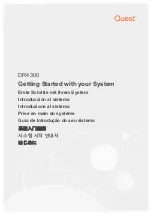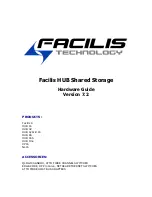
DS300f G2 Series User Manual
121
Quick Setup
– A sequence of four steps to setup system date and time, Management port, and RAID configuration.
See "Setting-up ASUS DS300f G2 with the CLU" on page <?>.
Subsystem Management
– Subsystem settings, Controller settings, statistics, lock/unlock the subsystem, set
date and time, Enclosure settings, FRUs and Topology.
Physical Drive Management
– Assign an alias, force a physical drive offline or online, clear a Stale or PFD
condition, change global physical drive settings, and locate a physical drive.
Disk Array Management
– Assign an alias, view array information, create and delete disk arrays, transport,
rebuild, PDM, and transition functions, accept and incomplete array, locate a disk array, create, and delete logical
drives.
Spare Drive Management – View a list of spare drives, create, modify, and delete spare drives, and run Spare
Check.
Logical Drive Management
– Assign an alias, set cache policies, view logical drive information, run initialization
and Redundancy Check, create a LUN clone, and locate a logical drive.
Network Management
– Set IP addresses for Virtual and Maintenance Mode Ports, gateway, and DNS server;
subnet mask.
Fibre Channel Management
– Node information, Port information, settings, SFPs, and statistics, Logged-in
devices, add intiator to the list.
iSCSI Management
– Targets, Ports, Portals, Sessions, iSNS options, CHAPs, Ping, Trunks, Logged-in devices,
add intiator to the list.
Background Activities
– Summary of running and scheduled activity, settings for Media Patrol, Auto Rebuild,
Rebuild, Migration, PDM, Transition, Synchronization, Initialization, Redundancy Check rate, and thresholds.
Event Viewer
– View runtime and NVRAM event logs.
Additional Info and Management
– LUN mapping, UPS management, User management, Software services
management, Flash through TFTP (Firmware update), Clear Statistics, Restore Default Settings, Shutdown or
Restart the subsystem.
Buzzer
– Enable, disable or silence the buzzer (audible alarm).
a
cceSSInG
o
nlIne
h
elP
To access online help on any CLU screen, press
Control-AE
.
To return to the CLU, press
Enter
.
e
xItInG
the
clu
1. Highlight
Return to Previous Menu
and press
Enter
.
Repeat this action until you arrive at the Main Menu.
2. From the Main Menu, highlight
Return to CLI
and press
Enter
to exit
3. Close the terminal emulation, Telnet, SSH, or terminal window.
l
oGGInG
o
ut
of
the
clI
When you shut down or restart the ASUS DS300f G2 subsystem, you are automatically logged out of the CLI.
To manually log out of the CLI (no shut down or restart):
At the
username@cli>
prompt, type logout and press
Enter
.
The prompt changes to
cli>
.
l
oGGInG
b
ack
I
nto
the
clI
anD
clu
To log into the CLI and CLU after a manual logout:
1. At the
cli:>
prompt, type login followed by your user name and press
Enter
.
2. At the Password: prompt, type your password and press
Enter
.
3. At the
username@cli>
prompt, type
menu
and press
Enter
to open the CLU.
Summary of Contents for DS300 G2 Series
Page 1: ...ASUS Storage DS300 G2 Series ...
Page 11: ......
Page 34: ......
Page 38: ......
Page 262: ......
















































